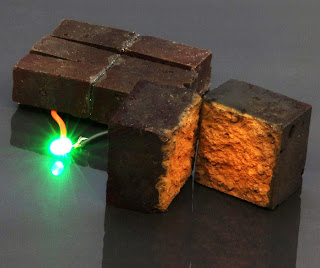Future Technology Ideas
Future Technology Ideas


Researchers led by Washington University in St Louis, in Missouri, US, have developed a method that can turn the cheap and widely available building material into “smart bricks” that can store energy like a battery.
Although the research is still in the proof-of-concept stage, the scientists claim that walls made of these bricks “could store a substantial amount of energy” and can “be recharged hundreds of thousands of times within an hour”.
2. Robotic Guide Dogs
A student at Loughborough University has designed a “robotic guide dog” that will help support visually impaired people who are unable to house a real animal.

The product, designed by Anthony Camu, replicates the functions of a guide dog as well as programming quick and safe routes to destinations using real-time data.
Theia, named after the titan goddess of sight, is a portable and concealable handheld device that guides users through outdoor environments and large indoor spaces with very little input.
3. Sweat Powered Smartwatches
Engineers at the University of Glasgow have developed a new
type of flexible super capacitor, which stores energy, replacing the
electrolytes found in conventional batteries with sweat.

It can be fully charged with as little as 20 microliters of fluid and is robust enough to survive 4,000 cycles of the types of flexes and bends it might encounter in use.
The device works by coating polyester cellulose cloth in a thin
layer of a polymer, which acts as the super capacitor’s electrode.

Tiny hybrid robots made using stem cells from frog embryos could one day be used to swim around human bodies to specific areas requiring medicine, or to gather microplastic in the oceans.

“These are novel living machines,” said Joshua Bongard, a computer scientist and robotics expert at the University of Vermont, who co-developed the millimetre-wide bots, known as xenobots.
5. Tactile Virtual Reality

In gaming, it could alert players when a strike occurs on the corresponding body part of the game character.
We can not seem to live without the internet but still only around
half the world’s population is connected. There are many reasons for this,
including economic and social reasons, but for some the internet just isn’t
accessible because they have no connection.

Their satellites orbit the Earth 16 times a day and are already being used by organizations like The British Antarctic Survey to provide internet access to very extreme of our planet.
If you want to take a trip into space, your quickest bet might be to take a balloon. The company World View Enterprises wants to send tourists into the stratosphere, 32km above Earth, on hot air balloons.

Technically ‘space’ is defined as 100km above sea level, but 32km is high enough to witness the curvature of the Earth, just as Felix Baumgartner did on his space jump. The balloon flew its first successful test flight in June.
Needles'
A “smart needle” has been developed by scientists in the UK which could speed up cancer detection and diagnosis times.

UK homes throw away 30 to 50 per cent of what we buy from supermarkets, says a 2013 report by the Institution of Mechanical Engineers. The report claimed we’re guided by ‘use by’ and ‘best before’ dates on food packaging, which are kept conservative because they are driven by shops’ desire to avoid legal action. An invention called ‘Bump Mark’ could change all that.



Comments
Post a Comment